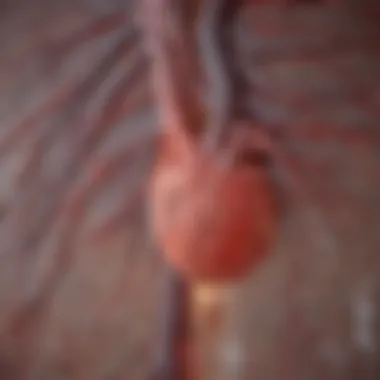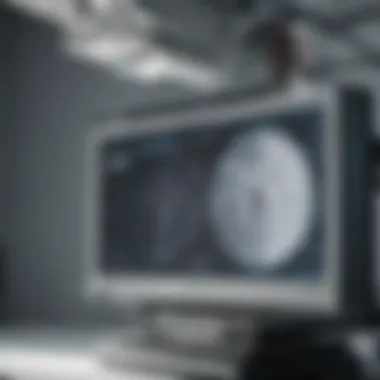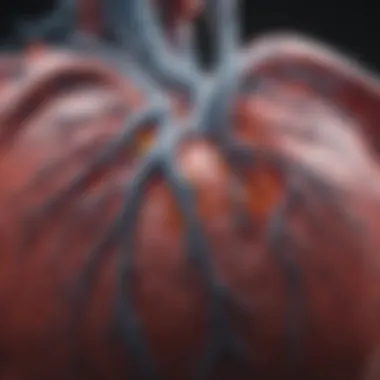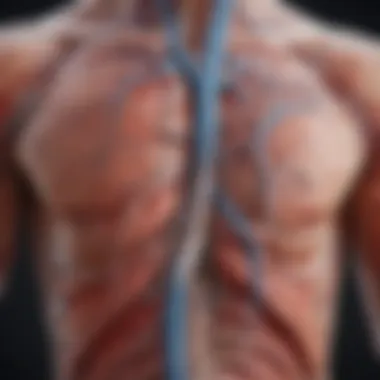CT Angiography: Comprehensive Insights for Cardiac Health


Intro
CT angiography (CTA) has transformed the landscape of cardiovascular imaging. Compared to traditional methods such as invasive angiography, CTA offers a less invasive alternative with high-resolution images. This technique is pivotal in diagnosing and managing coronary artery diseases and other cardiac conditions.
A significant aspect of CTA is how it highlights the anatomical structures of the vascular system. It allows healthcare providers to visualize the heart and its anatomy in detail. With the ability to assess coronary blood flow non-invasively, CTA has gained prominence among clinicians and radiologists alike.
Research Context
Background Information
The foundation of CT angiography lies in advances in computed tomography technology and radiological techniques. Initially, this method relied on older imaging modalities, which provided limited diagnostic information about cardiovascular diseases. Over the years, developments in multidetector computed tomography (MDCT) have significantly increased the diagnostic accuracy of CTA. The speed of image acquisition and enhanced spatial resolution have made CTA the preferred modality for many cardiological assessments.
Importance of the Study
Assessing the role of CT angiography in cardiac evaluation is crucial. Understanding its clinical applications enables healthcare professionals to utilize it effectively for better patient outcomes. It is important to evaluate not only the successes attributed to CTA but also its limitations and potential challenges. By evaluating current research and methodologies, this discourse aims to provide insights that can inform clinical practice and guide future research developments in this field.
Discussion
Interpretation of Results
Recent studies illustrate the effectiveness of CT angiography in diagnosing obstructive coronary artery disease. Research indicates that CTA is comparable to invasive coronary angiography in terms of diagnostic performance. However, it is essential to consider patient selection and the specific clinical context when interpreting these findings. The ability to assess both the coronary arteries and adjacent structures provides a comprehensive understanding of the cardiovascular system.
Comparison with Previous Research
Historically, CTA faced skepticism regarding its utility in assessing the coronary arteries. Earlier studies showed variability in sensitivity and specificity. Modern research presents a different narrative, showcasing advancements in technology and the increased accuracy of CTA in contemporary clinical settings. Consequently, it is imperative to analyze various studies for a holistic comprehension of CTA's evolving role in cardiac assessment.
"CT angiography serves as a crucial bridge in the management of cardiovascular disease, providing invaluable insights into the anatomy of the heart while minimizing patient risk."
Closure
Through a thorough examination of CT angiography, this article emphasizes its role in modern cardiology. The discussion extends beyond its application to highlight challenges and future development areas. By fostering a deeper understanding of CT angiography, healthcare professionals can leverage this knowledge to enhance diagnostic precision and patient care in cardiovascular medicine.
Prologue to CT Angiography
CT angiography (CTA) is an essential imaging technique that has profoundly transformed the field of cardiovascular assessment. This subsection illuminates the significance of CTA by discussing its definition, purpose, and historical context. As healthcare evolves, the need for precise and effective diagnostic tools becomes paramount, making CTA integral to modern cardiology.
Definition and Purpose
CT angiography is a non-invasive imaging modality used to visualize the blood vessels and structures within the cardiovascular system. It employs computed tomography technology along with contrast agents to produce detailed images of the arteries. The primary purpose of CTA is to assess the presence and extent of vascular diseases, such as coronary artery disease. By providing high-resolution images, it allows for better diagnosis, treatment planning, and monitoring of various cardiac conditions. The speed and accuracy of CTA are significant advantages that enhance patient care.
Historical Background
The origin of CT angiography can be traced back to the advances in both computed tomography and contrast imaging techniques. The first successful CT scan was performed in the early 1970s, leading to the gradual development of CTA. In the mid-1990s, the introduction of multi-slice CT technology allowed for faster acquisition of images, making three-dimensional reconstructions possible. Over the years, CTA has seen refinements in image quality, reduction in radiation doses, and improved patient safety protocols. This evolution has made CTA one of the preferred methods for cardiovascular assessment, shaping clinical practice in cardiology today.
Technical Overview of CT Angiography
Understanding the technical aspects of CT angiography is crucial for comprehending its application in cardiac assessment. This section elaborates on the principles of computed tomography, the contrast agents utilized, and the imaging protocols that guide the process. Mastery of these elements equips medical professionals with the knowledge necessary for effective diagnosis and treatment planning.
Principles of Computed Tomography


Computed tomography (CT) is a sophisticated imaging technique that synthesizes multiple X-ray measurements taken from various angles around the body. The data is processed by a computer to produce cross-sectional images, or slices, of internal structures. This methodology allows for a detailed visualization of anatomical areas, particularly blood vessels.
In CT angiography, a specialized protocol focusing on the evaluation of vascular structures is adopted. High-speed rotation of the X-ray tube around the patient results in the generation of refined images. The spatial resolution is enhanced through the use of multi-slice technology, which can capture several slices simultaneously. This technique allows for rapid imaging, which is critical in emergency settings.
Contrast Agents Used
Contrast agents are vital in enhancing the visibility of blood vessels during CT angiography. These substances are intravenously injected into the patient, resulting in a significant difference in radiographic density between the blood vessels and surrounding tissues. Iodine-based contrast media are predominantly employed due to their high atomic number and efficacy in producing sharp images.
However, the use of contrast agents necessitates careful consideration of patient safety. Adverse reactions can occur, though they are relatively rare. Healthcare providers must evaluate patients for any history of allergic reactions to iodine or impaired renal function prior to administration. Knowledge of these agents ensures that clinicians can make informed choices during the imaging process.
Imaging Protocols
The imaging protocols in CT angiography involve meticulous planning to achieve optimal results. A standard protocol includes the preparation of the patient, selection of the appropriate scanner, and specific scanning parameters. Factors such as tube current, voltage, and rotation time are adjusted based on the clinical requirement and specific anatomical focus.
Before the procedure, patients may be requested to fast and hydrate. This can help improve the quality of images acquired. Furthermore, timely injection of the contrast agent is essential to synchronize with the imaging acquisition, particularly when assessing the coronary arteries or detecting pathologies in real time.
Clinical Applications of CT Angiography
CT angiography plays a crucial role in diagnosing and managing various cardiac conditions. Its non-invasive nature and detailed imaging capabilities make it an invaluable tool for healthcare professionals. This section delves into several key clinical applications where CT angiography shines, examining the benefits and considerations for each.
Assessment of Coronary Arteries
The assessment of coronary arteries is one of the most significant applications of CT angiography. This imaging technique allows for a rapid and accurate evaluation of coronary artery disease. Healthcare providers can assess arterial blockages and plaques without the need for invasive procedures. This is beneficial because it minimizes patient discomfort and reduces recovery time.
Accurate visualization of the coronary arteries can help in determining the severity of the disease. The ability to quantify stenosis assists in making informed treatment decisions, such as whether to proceed with medical management or interventional procedures. Furthermore, CT angiography enables the identification of atypical coronary anomalies, which is essential for proper planning in complex cases. The integration of CT angiography into standard cardiac assessments has led to improved outcomes for patients with coronary artery disease.
Evaluation of Congenital Heart Disease
Another important application is in the evaluation of congenital heart disease. CT angiography offers a comprehensive view that can help identify structural anomalies within the heart and surrounding vessels. This imaging technique supports the characterization of congenital defects, providing detailed information on anatomy.
The depiction of blood flow patterns within complex congenital heart diseases can guide treatment options. Furthermore, it can assist in preoperative planning for surgical interventions. The accuracy of CT angiography in evaluating anomalies can lead to better surgical outcomes and overall patient care. Once again, the non-invasive approach reduces the need for more invasive diagnostic procedures, which can pose greater risks.
Utility in Preoperative Planning
CT angiography holds significant value in preoperative planning. Surgeons require precise anatomical information to ensure successful outcomes. This imaging modality allows for 3D reconstructions that enhance visualization of the heart and vascular structures. Such clarity helps in understanding the relationship between various structures before surgery.
By incorporating CT angiography in preoperative assessments, clinicians can identify potential complications and tailor surgical approaches accordingly. This not only improves surgical efficiency but also enhances patient safety. The detailed nature of CT data allows surgeons to rehearse complex procedures in a virtual environment, leading to more confident and prepared surgical teams.
Role in Acute Chest Pain Assessment
CT angiography is increasingly utilized in the assessment of acute chest pain. When a patient presents with chest pain, distinguishing between cardiac and non-cardiac causes is critical. CT angiography can rapidly evaluate coronary artery disease, helping to rule out life-threatening conditions such as myocardial infarction.
The speed and accuracy of CT angiography in this context can lead to timely diagnoses and interventions. This is invaluable in emergency settings where every moment counts. Reducing the time to diagnosis can improve outcomes significantly, allowing for prompt treatment and reducing hospital stays.
"CT angiography represents a vital tool for acute chest pain assessment, providing quick and reliable results that can save lives."
This section highlights several clinical applications of CT angiography. Its contributions to the assessment of coronary arteries, evaluation of congenital heart disease, utility in preoperative planning, and role in acute chest pain assessment underscore its significance in contemporary medical practice. The advancements in this imaging modality continue to enhance patient care and improve clinical decision-making.
Advantages of CT Angiography


CT Angiography offers compelling benefits that enhance its role in cardiac assessment. Understanding these advantages can help clinicians and patients make informed decisions regarding their cardiovascular health. This section highlights the key advantages, which include its non-invasive nature, speed and efficiency, and detailed visualization of blood vessels.
Non-Invasive Nature
One of the most significant advantages of CT Angiography is its non-invasive characteristic. Unlike traditional angiography, which usually involves catheter insertion and can be painful, CT Angiography allows for imaging without physical intrusion. This aspect is invaluable for patients who may have a strong aversion to invasive procedures. The scan can be performed rapidly, minimizing discomfort and risk. The absence of biopsy or catheterization reduces the potential for complications such as infection or bleeding. Overall, the non-invasive nature elevates patient comfort and makes it a preferred option in many cases.
Speed and Efficiency
CT Angiography is known for its rapid execution compared to other imaging modalities. A typical scan can be completed in just a few minutes. This efficiency is crucial in acute care settings where time is of the essence, such as during myocardial infarction or other urgent situations. Because results are available quickly, clinicians can make timely decisions regarding treatment. Patients also benefit from reduced waiting times, which can lessen anxiety and facilitate a faster return to normal activities. Additionally, the technique's automation allows for enhanced workflow, making it suitable for busy clinical environments.
Detailed Visualization of Vessels
The capability of CT Angiography to provide high-resolution, detailed images of blood vessels is another key strength. This method allows for the assessment of both coronary arteries and peripheral vascular beds with remarkable clarity. The use of advanced algorithms and high-powered imaging technology ensures that even subtle abnormalities are detected.
High-resolution images help in identifying blockages, stenosis, or abnormalities more accurately, leading to better diagnosis and treatment planning.
Clinicians can monitor the progression of disease with precision, which aids in personalized treatment strategies. Moreover, visualizing complex anatomical structures is made simpler. This detailed imaging is essential not only for diagnosis but also for planning surgical interventions if necessary.
In summary, the advantages of CT Angiography make it an essential imaging tool in cardiology. Its non-invasive approach, swift execution, and superior imaging capabilities contribute significantly to effective cardiac assessments.
Limitations and Considerations
Understanding the limitations and considerations associated with CT angiography is essential for a comprehensive assessment of its use in clinical practice. While this imaging modality offers several benefits, awareness of its shortcomings ensures that healthcare professionals make informed decisions regarding patient care. This section delves into significant factors that warrant consideration before and during the use of CT angiography.
Comparison with Other Imaging Modalities
In the realm of cardiovascular assessment, evaluating different imaging modalities is crucial. Each technology has its strengths and limitations. This section will consider the differences between CT Angiography and other commonly used imaging methods. Understanding these contrasts enables healthcare professionals to select the most appropriate tool for specific clinical situations.
CT Angiography vs. Traditional Angiography
CT Angiography and traditional angiography represent two distinct approaches towards vascular imaging. Traditional angiography, often referred to as invasive or catheter-based angiography, involves inserting a catheter into the vascular system to inject a contrast agent directly into blood vessels. This method allows for detailed observation but comes with inherent risks, such as bleeding and infection at the insertion site. Furthermore, traditional angiography requires significant preparation, including patient fasting and potentially lengthy recovery times.
On the other hand, CT angiography provides a non-invasive alternative. It employs X-ray technology to capture high-resolution images after the patient receives an intravenous contrast agent. One notable benefit is the much shorter procedure time. In many instances, CT Angiography can be performed in an outpatient setting. This advancement not only enhances patient comfort but also leads to a higher patient turnover for healthcare providers.
However, traditional angiography has its advantages as well. It allows for real-time intervention during imaging, such as balloon angioplasty or stenting. In complex cases, where immediate therapeutic decisions are required, traditional angiography remains the gold standard. Therefore, the choice between the two methodologies should come down to clinical necessity, patient safety, and available resources.
CT Angiography vs. MRI for Cardiac Assessment
Magnetic Resonance Imaging (MRI) is another imaging modality that has gained traction in cardiac evaluation. When comparing CT Angiography with MRI, one must consider several factors, including imaging speed, detail resolution, and overall accessibility. CT Angiography is renowned for its swift image acquisition, often taking just a few breaths from the patient. In contrast, MRI typically takes longer due to its complex imaging sequence involving multiple slices and viewpoints.
MRI does not employ ionizing radiation, which is a significant concern in many cases, particularly in younger patients. This aspect can make MRI a more favorable option, especially in clinical follow-ups or screening situations. However, CT Angiography’s detailed visualization of coronary arteries often proves superior in identifying acute coronary syndrome.
It's also important to note the contraindications. For instance, patients with pacemakers, certain implants, or severe claustrophobia may not tolerate MRI well. In contrast, CT Angiography, while having its contraindications relating to renal function and allergies to contrast agents, can accommodate more patients overall.
Both CT Angiography and MRI contribute uniquely to cardiac assessment, and understanding their differences improves clinical decision-making.
Future Directions in CT Angiography
The evolving landscape of cardiovascular imaging is heavily influenced by advancements in technology and a growing emphasis on integrated diagnostic approaches. Understanding future directions in CT angiography is essential for professionals in the field as it informs both practice and innovation. The future hinges on several critical elements which can refine and enhance the utility of this imaging modality.


Technological Advancements
Recent years have seen significant progress in CT technology which directly impacts angiography. High-definition imaging capabilities have improved, enabling exceptional resolution and detail in vascular visualization. Newer scanners, featuring faster image acquisition rates, minimize motion artifacts and significantly enhance the quality of imaging during shorter breath holds. This is crucial for cardiac assessments where precise imaging can directly influence treatment decisions.
Additionally, advancements in dual-energy CT and advanced post-processing techniques allow for more detailed characterization of vascular lesions. Such innovations help distinguish between calcified and non-calcified plaques, offering deeper insights into cardiovascular risk.
Moreover, machine learning and artificial intelligence enhance image interpretation and diagnostic accuracy. Algorithms trained with vast datasets can assist radiologists by highlighting areas of interest or potential abnormalities in scans. The incorporation of AI could lead to greater efficiency and robustness in diagnostic workflows.
Integration with Other Diagnostic Tools
Combining CT angiography with other diagnostic modalities is likely to prepare the ground for comprehensive cardiovascular assessments. For instance, the integration of CT with MRI could provide complementary information. While CT angiography excels in depicting the anatomy of vascular structures, MRI offers superior functional assessment of myocardial tissue. This fusion could significantly enhance patient management strategies.
Concurrently, utilizing positional emission tomography (PET) or single photon emission computed tomography (SPECT) alongside CT angiography can facilitate the evaluation of coronary artery disease. This combined approach, often termed hybrid imaging, can not only provide anatomical detail but also functional information about the myocardium.
The intersection of innovative technology and diagnostic modalities reinforces the capacity of cardiologists to deliver precision medicine for patients.
Ultimately, the future of CT angiography will likely lean toward a tailored approach for patients. Increasing emphasis on personalized medicine might shift focus toward specific patient populations and their unique cardiovascular risks. Continuous research and clinical trials will be critical in determining the best practices for applying these technological advancements in real-world scenarios.
This line of inquiry represents an exciting frontier that combines computational power with critical clinical needs, ensuring that CT angiography remains a centerpiece in the assessment of cardiovascular health.
End
In this article, the significance of CT angiography in cardiac assessment has been thoroughly articulated. CT angiography stands out as a non-invasive imaging technique that plays a critical role in diagnosing and evaluating various cardiovascular conditions. Its ability to provide detailed visualization of blood vessels enables healthcare professionals to make informed decisions for patient management.
One of the key benefits of CT angiography is its efficiency. Unlike traditional angiography, which often requires longer procedures and more invasive techniques, CT angiography can deliver rapid results with high accuracy. This speed can be crucial in acute scenarios, such as assessing patients with chest pain, where timely intervention can save lives.
Moreover, the limitations associated with CT angiography, such as radiation exposure and potential artifacts, necessitate careful consideration in clinical practice. It is vital for practitioners to weigh the advantages against these limitations when determining the most suitable imaging modality for their patients.
Future advancements in technology and methodologies promise to enhance the efficacy of CT angiography even further. Integration with other diagnostic tools can lead to a more comprehensive understanding of cardiovascular health.
"Understanding the dynamics of CT angiography can profoundly influence cardiac care and treatment pathways."
Overall, the insights provided in this article will equip students, researchers, educators, and professionals with a deeper understanding of CT angiography's role in modern medicine. This knowledge is essential for navigating the complexities of cardiovascular diseases and optimizing patient outcomes.
References and Further Reading
In the realm of CT angiography, a comprehensive understanding requires more than just foundational knowledge. The section on References and Further Reading serves multiple important purposes for healthcare professionals, researchers, and students alike. By directing readers to credible sources, this section enhances the depth of knowledge and promotes ongoing education.
Importance of References
References are crucial in maintaining the integrity of information. Reliable sources validate the claims made throughout the article. This gives credence to the findings and provides context concerning the advancements in CT angiography. Citing peer-reviewed journals, established medical guidelines, and authoritative textbooks forms the backbone of a well-informed discussion.
Advantages of Further Reading
- Expanded Knowledge: Engaging with recommended texts or articles allows readers to delve deeper into complex topics around CT angiography such as techniques, case studies, and emerging research.
- Stay Updated: In a constantly evolving field like cardiology, staying informed about the latest trends, radiological advancements, and clinical applications is essential.
- Diversified Perspectives: Different authors often provide unique insights that can supplement the reader's understanding and approach to CT angiography.
Considerations in Sources
- Ensure sources are current to reflect the rapidly changing technology in medical imaging.
- Peer-reviewed articles are preferred as they have been scrutinized by experts in the field.
- Texts that encompass both theory and practical applications enrich the learning experience.
"Ongoing education is key in the field of medical imaging to keep abreast of innovations and best practices."
Recommended Resources
- Wikipedia on CT Angiography: For a broad overview, including technical details and historical context. Wikipedia
- Britannica on Medical Imaging: For curated articles that discuss various imaging modalities, including CT angiography. Britannica
- Reddit Communities: Engaging in discussions with professionals can yield practical advice and insights into the real-world applications of CT angiography. Reddit
- Facebook Groups: Networking with peers in specialized groups can enhance both professional relationships and knowledge sharing. Facebook
In summary, the References and Further Reading section is not merely an addendum; it is a vital component of the article. It encourages further exploration and supports the claim that CT angiography is an essential tool in modern cardiology.















